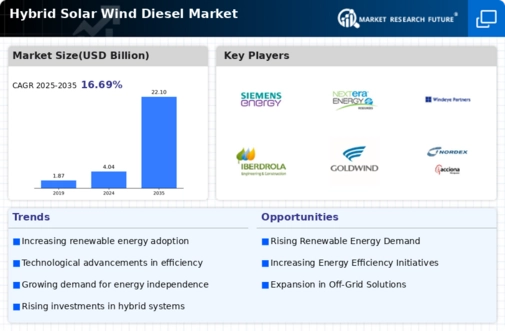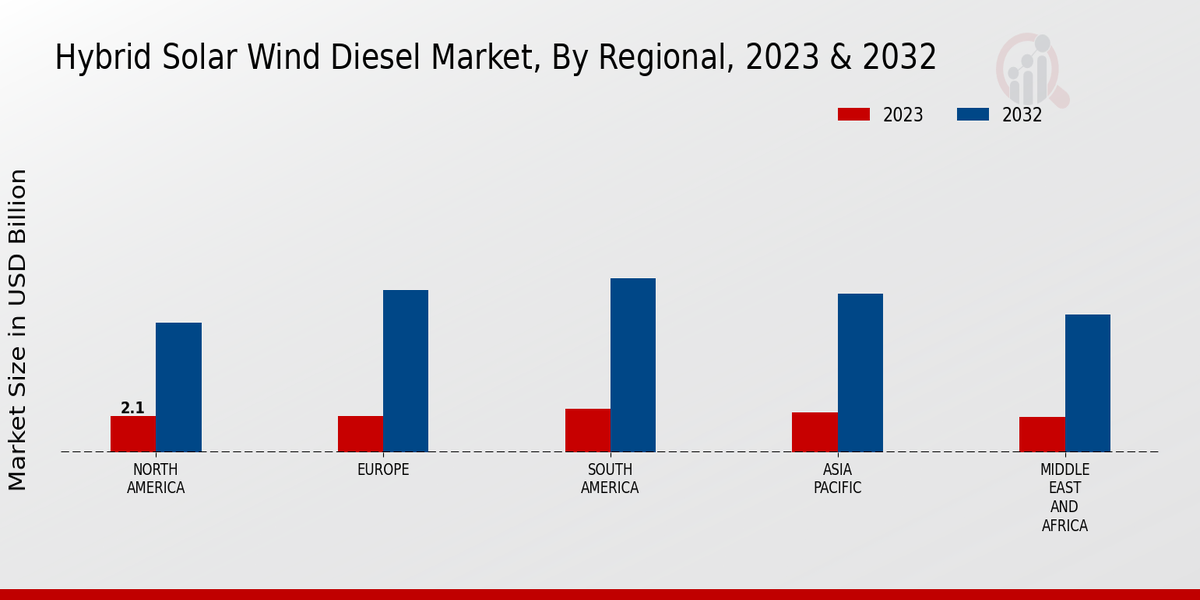Rising Electricity Costs
The Global Hybrid Solar Wind Diesel Market Industry is influenced by the rising costs of electricity, which compel consumers and businesses to seek alternative energy solutions. As traditional energy prices fluctuate, hybrid systems present a cost-effective option for energy generation. For example, in regions where electricity prices are high, such as parts of Europe and Asia, the adoption of hybrid systems can lead to substantial savings. This economic incentive is driving the market's growth, as consumers increasingly recognize the long-term financial benefits of investing in hybrid energy solutions. The combination of cost savings and sustainability is likely to attract more investments in the sector.
Market Growth Projections
The Global Hybrid Solar Wind Diesel Market Industry is projected to witness substantial growth in the coming years. With a market value anticipated to reach 22.1 USD Billion by 2035, the industry is poised for significant expansion. The projected CAGR of 16.68% from 2025 to 2035 indicates a robust upward trend, driven by factors such as technological advancements, government support, and increasing demand for renewable energy. This growth trajectory suggests that hybrid systems will play an essential role in the global energy landscape, as more stakeholders recognize their potential to provide sustainable and reliable energy solutions.
Government Incentives and Policies
Government incentives and supportive policies are crucial drivers for the Global Hybrid Solar Wind Diesel Market Industry. Many countries are implementing subsidies, tax breaks, and grants to encourage the adoption of hybrid energy systems. For instance, the United States and Australia have introduced various programs aimed at promoting renewable energy investments. These initiatives not only lower the financial barriers for consumers but also stimulate market growth. As governments worldwide continue to prioritize renewable energy, the hybrid market is likely to benefit from increased funding and support, contributing to a projected CAGR of 16.68% from 2025 to 2035.
Rising Demand for Renewable Energy
The Global Hybrid Solar Wind Diesel Market Industry is experiencing a surge in demand for renewable energy sources. As nations strive to meet their climate goals, the integration of hybrid systems becomes increasingly attractive. For instance, countries like Germany and Denmark have made substantial investments in renewable energy infrastructure, leading to a projected market value of 4.04 USD Billion in 2024. This shift towards cleaner energy solutions is driven by both governmental policies and consumer preferences, indicating a robust growth trajectory for hybrid systems. The emphasis on sustainability is likely to propel the market further as more regions adopt similar strategies.
Increasing Energy Security Concerns
The Global Hybrid Solar Wind Diesel Market Industry is also driven by growing concerns over energy security. As geopolitical tensions and supply chain vulnerabilities become more pronounced, nations are seeking to diversify their energy sources. Hybrid systems, which combine solar, wind, and diesel power, offer a reliable solution to mitigate risks associated with energy dependence. Countries like India and South Africa are investing in hybrid technologies to enhance their energy resilience. This trend towards energy independence is likely to propel the market forward, as more regions recognize the benefits of hybrid energy solutions in ensuring stable energy supplies.
Technological Advancements in Hybrid Systems
Technological innovations play a pivotal role in the Global Hybrid Solar Wind Diesel Market Industry. Recent advancements in energy storage solutions and smart grid technologies enhance the efficiency and reliability of hybrid systems. For example, the development of high-capacity batteries and improved inverter technologies allows for better integration of solar and wind energy with diesel generators. These innovations not only reduce operational costs but also improve energy management, making hybrid systems more appealing to consumers. As technology continues to evolve, the market is expected to expand significantly, potentially reaching a value of 22.1 USD Billion by 2035.























Leave a Comment